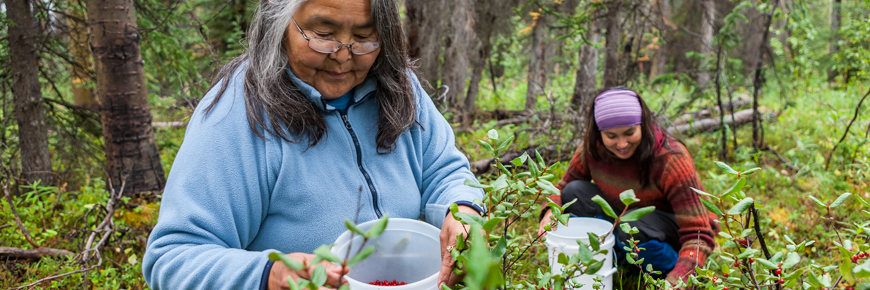
Dän Keyi (Our people’s land)
Kluane National Park and Reserve
The impressive natural landscape of Kluane is part of the traditional territory of the Southern Tutchone people represented in the Kluane region by the Champagne and Aishihik First Nations and the Kluane First Nation. Today, Champagne and Aishihik First Nations, Kluane First Nation and Parks Canada are jointly responsible for the management of the park’s natural and cultural resources.
Southern Tutchone culture | Traditional knowledge and the Southern Tutchone language | Kluane Game Sanctuary | Rediscovering Dän Keyi (Our people’s land) | Ä́’sía Keyi - Grandfather's Land music video | Cooperative management | More information
Southern Tutchone culture
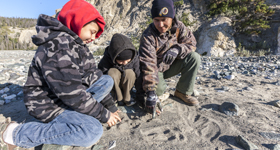
Since time immemorial, the Southern Tutchone people, which include Champagne and Aishihik First Nations and Kluane First Nation, have lived throughout the area that is now Kluane National Park and Reserve. Over thousands of years dän (the people) have developed effective methods for living in this land of extremes. Elders recall a rich history which details events and places spanning many generations.
They once lived a nomadic lifestyle, travelling great distances, in order to take advantage of seasonal abundances of wildlife and plants throughout their traditional territory. This lifestyle required developing a superior skill set of hunting and travelling techniques in an area of harsh climatic and geographic variations.
Traditional knowledge and the Southern Tutchone language
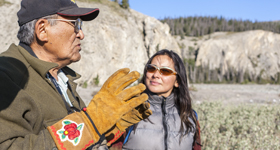
The accuracy and depth of the Southern Tutchone language was key to the survival of the dän. Formal teachings as well as traditional stories told by Elders were and continue to be passed on orally. Place names and the stories associated with them were a source of critical knowledge; they identified where resources could be found, referred to past events, and described the terrain in a way that a traveller would have knowledge of a place without having been there before.
The Southern Tutchone name for Kluane Lake is “Łù’àn Män” meaning "big fish lake". The coastal Tlingits, who were trading partners, called the area “ùxh-àni” meaning "whitefish country". The name 'Kluane' (pronounced ‘Kloo-wah-nee’) was derived from these two names by early settlers.
Southern Tutchone place names now featured on highway signs
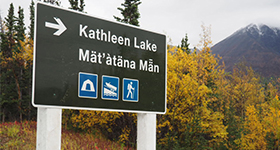
Next time you’re driving down the South Klondike, Haines or Alaska Highway from the south to the north boundary of Kluane National Park, have a look at Parks Canada’s new highway signs. Place names are now featured in the Southern Tutchone language as well as English.
Working together with Yukon Government Department of Highways, Champagne and Aishihik First Nations, and Kluane First Nation, Parks Canada has installed forty eight new signs along the Haines and Alaska Highways. These signs will offer residents and visitors alike an increased awareness of access to trails and amenities in Kluane National Park and Reserve, as well as learning Indigenous place names while travelling through First Nations traditional territory.
Kluane Game Sanctuary
In 1943, the Kluane Game Sanctuary was established and First Nations were denied access to hunting, fishing and trapping in a significant portion of their traditional territory. This separation caused their special bond with those lands to break, resulting in a great cultural and personal loss that has now affected five generations. With the implementation of their land claim and the establishment of Kluane National Park and Reserve, they have reasserted their right to carry out traditional activities in the park and the surrounding Kluane Game Sanctuary lands.
Rediscovering Dän Keyi (Our people’s land)
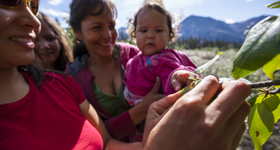
Today, the Southern Tutchone people continue to maintain a rich culture based on strong ties with the natural world. Renewing their relationship with their traditional territory within the park, and providing direction in the management of the natural resources are high priorities for both Champagne and Aishihik First Nations and Kluane First Nation. This cultural reintegration will also help ensure that the First Nations’ traditional knowledge of this region is recognized and carried forth into the future.
Watch the music video
Ä́’sía Keyi - Grandfather's Land
Cooperative management
The Champagne and Aishihik First Nations Final Agreement and the Kluane First Nation Final Agreement ushered in a new era in the management of Kluane National Park and Reserve. The Champagne and Aishihik First Nations Final Agreement established the creation of the Kluane National Park Management Board and the two final agreements identify specific rights and responsibilities of the two First Nations, the Board and Parks Canada in the management of the park – a cooperative management regime based on shared responsibility.
Kluane National Park Management Board
More Information
- Yukon First Nations (Virtual Museum of Canada)
- Kluane National Park and Reserve Management Plan
- Traditional Harvesting Activities in Kluane National Park and Reserve
Related links
- Date modified :


 Kluane First Nation
Kluane First Nation